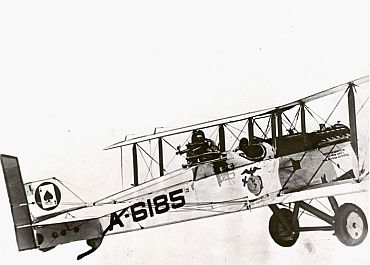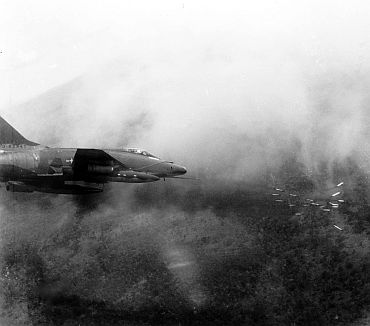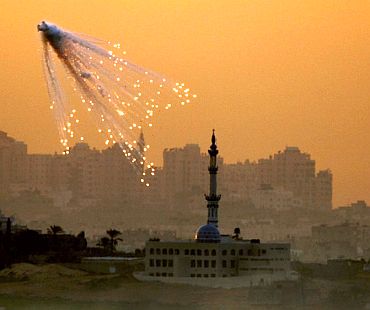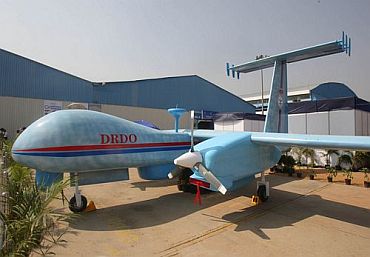Photographs: Adnan Abidi/Reuters M P Anil Kumar
Heracles (Hercules), an exterminator of chthonic monsters in Greek mythology, was characterised by masculinity, courage, ingenuity, deception and vengeance. Driven mad by Hera, he slew his own children. As expiation for the beastly felony, Eurystheus -- his archenemy and king -- sentenced Heracles to carry out 10 labours.
One task was to slay the Lernaean Hydra, a serpent-like monster with many heads. Besides one of these being immortal, the snag with the other heads was that as soon as he beheaded one, two others sprung up in its place.
Heracles eventually accomplished the task by burning the decapitated heads with the aid of his cousin Ioloas.
Whether it be the slaughtering of 76 Central Reserve Police Force personnel in Chintalnar (Dantewada, Chhattisgarh) or the derailing of the Jnaneswari Express in West Midnapore (West Bengal) that snuffed out 148 passengers, or other fatalities of Maoist violence, the clamour in the media for the deployment of the armed forces grows shriller with each onslaught.
As activating the armed forces to put the Maoists to the sword would be counterproductive, both the army and air chiefs aired their opinion publicly on the inadvisability of the drastic measure. A hypertensive sect of the commentariat went ballistic and excoriated the chiefs for speaking out of turn.
If only these belligerent gentry had kept in mind the context, and the gravitas. The real provocation was the double take of Home Minister P Chidambaram on the Chintalnar carnage. Chidambaram imperiously said it could be time to reconsider using the army and air force in the government's fight against the Maoists.
Air Chief Marshal P V Naik felt, 'The Maoist situation has not reached a stage where the armed forces have to be deployed,' adding, 'One has to be careful in using offensive airpower against your own people in our own territory.' What's so hair-raising in his statement, somebody?
The state police and the central paramilitary forces, no doubt, have been unable to curb Maoists' violence, but does it warrant the panicky 'call to arms' of the Services?
...
Airpower's effectiveness is questionable
Image: A Marine Corps de Havilland DH-4 flown in NicaraguaPhotographs: Courtesy: US Marine Corps
Vignettes from insurgencies
In 1919, the pugnacious Emir of Afghanistan declared jihad against the British in the Northwest Frontier province. The Royal Air Force retaliated by dropping four 112-pound and sixteen 20-pound bombs over Kabul from a Handley Page biplane bomber.
Presto, the Emir threw in the towel! More than the physical devastation, the psychological punch of bombing was what drove him to scramble for the white flag. That is how puissant airpower is!
Small wonder then that nations rarely refrain from using airpower against the insurgents, but its true effectiveness in vanquishing insurgencies is contestable.
Being the 'cradle of aviation', it was but natural for the Americans to emerge as the foremost exponent of airpower.
► Nicaragua: Nicaraguan President Jose Zelaya, livid at the choice of Panama by the United States for the site of a transisthmian sea canal, invited Germany and Japan for a competing canal across Nicaragua.
To protect its interests, the US fathered a civil war in Nicaragua in October 1909. The onslaught of the US-backed rebels forced President Zelaya to resign in December.
The US intervened in Nicaragua almost uninterruptedly from 1909 to 1933, and the US Marines occupied the main cities. Augusto Sandino, the father of the Nicaraguan revolution, led the rebellion against the US occupation through a guerrilla war.
In 1927, the US decided to take the wind out of the Nicaraguan revolution by using airpower. The US aviators, dressed in Nicaraguan uniform, strafed and bombed Sandino's strongholds, and attacked Mexican seaborne traffic providing logistical support to the resistance fighters.
Expectedly, the air raids were very effective and the rebels suffered substantial reverses. The novelty of airpower had the resisters reeling on the back foot. The guerrillas, however, learned to scatter themselves, operate in small contingents and regroup to engage in skirmishes. Soon the effectiveness of air raids wore out.
The US forces also used aircraft as observation outposts, to drop propaganda leaflets, glean intelligence and to ferry crack special-operations squads. Well-versed in field craft, Sandino's fighters used camouflage and the dense jungle canopies to negate the US surveillance.
With the local population squaring up to the US forces, Sandino's men dug in their heels and easily held out. The US Marines sailed home in January 1933.
The Vietnam case study
Image: A US Air Force F-100 Super Sabre fires a salvo of rockets at a jungle target in Vietnam, May 1967Photographs: US Air Force Photo
The Vietcong (the organisation in South Vietnam and Cambodia) and the North's communist government allied with the Soviet Union and China to fight against the South Vietnamese government and the US forces in the Vietnam War (1959 to 1975).
The Vietcong had both guerrilla and regular army units, as well as a network of cadres who organised peasants in the territory it controlled. A whiz at camouflage and concealment, the Vietcong, apart from building an array of well-stocked encampments deep in the jungles, had dug warrens of tunnels, where they stayed, trained and planned their operations.
Since tactical bombers and fighter-bombers failed to disrupt enemy troop concentrations and supply depots, the US commanders called in the big daddy -- the B-52 strategic bomber.
The first B-52 raids against a Vietcong jungle sanctuary in South Vietnam took place on June 18, 1965, and were ineffective. (By the way, in the same month, two Guam-based B-52s collided midair over South China Sea near the Philippines.)
A massive 1966 bombing mission by 30 B-52s attempted to pulverise vital stretches of the strategic Mu Gia pass. Two days later, the traffic was moving again, despite huge landslides caused by the bombs and numerous delayed action munitions.
A desperate American President Lyndon B Johnson even ordered the bombing of North Vietnam's railways, modest industries and fuel dumps. The North Vietnamese responded to the bombing by dispersing fuel across the country in small drums and hauling supplies around on bicycles!
All the while, the US commanders were quite convinced that carpet-bombing was the trick to smoke out the Vietcong. This despite the known Vietcong policy of not leaving behind dead bodies, thus reducing body count to mere guesswork, which meant the US generals were left to extrapolate in the dark about the real attrition!
According to a Vietnam Veterans group, 6,727,084 tons of bombs were dropped on Indochina by the US during the Vietnam War. Not to mention the lethal chemical weapons Napalm and Agent Orange; while Napalm burned, Agent Orange caused diseases.
Outwitted and outfought, the last of US troops left Saigon, ignominy writ large, ahead of an advancing North Vietnamese Army. Saigon (now Ho Chi Minh City), the capital of South Vietnam, fell on April 30, 1975. The two halves were merged on July 2, 1976 as the Socialist Republic of Vietnam, or simply Vietnam.
Airstrikes never result in swift victory
Image: A shell bursts during Israel's attack on Gaza, 2009Photographs: Reuters
Hezbollah emerged in response to the 1982 Israeli invasion of Lebanon. Hamas, created in 1987 at the beginning of the First Intifada -- an uprising against Israeli rule in the Palestinian territories -- has a presence in the Gaza Strip and West Bank.
Israel has generally been unrestrained in its resort to air strikes to pound both Hamas and Hezbollah hideouts as retribution for rocket attacks and other acts of terror on Israeli soil.
Despite a formal blockade enforced by Israel and Egypt since June 2007 on Gaza, the elements of Hamas continue to be alive and kicking. After the 2005 elections, Hamas controls Gaza politically. And Hezbollah has grown to an organisation with seats in the Lebanese government.
► Turkey: Abdullah Ocalan founded the Kurdistan Workers' Party (PKK) in 1978, and led an armed uprising inside southeast Turkey since 1984 to create an independent Kurdish state (for the ethnic Kurds inhabiting the vast marches straddling the Iraq-Turkey border). He was captured in Kenya on February 15, 1999, stood trial in Turkey, was sentenced to death, which was later commuted to life term.
Post-incarceration, in a significant volte face, Ocalan has crusaded for a peaceful resolution of the Kurdish conflict. Though the PKK declared a ceasefire in April 2009, the Turkish army continues its hot pursuit, F-16 fighter jets of the Turkish Air Force regularly raid rebel redoubts across the border in Northern Iraq.
Undiminished violence looms to unhinge the Turkish-Kurdish rapprochement. More than 37,000 people have been killed in the Turkey-PKK conflict so far, and the strife continues to fester.
Era of smart bombs
The espousers of strategic bombing in aerial warfare believe that airpower, through its destructive and psychological impact, could facilitate swift victory with minimal trench casualties. Though the potential of airpower to strike it rich is immense in big wars, its potency to influence the outcome of small wars (against irregular or guerrilla outfits) isn't as telling.
► Iraq, Serbia: By decimating Saddam Hussein's regular forces, the two Gulf Wars showcased the destructive power of new-generation precision-guided weapons. NATO's air campaign in Kosovo (Serbia, March-June 1999) reiterated the capability of precision munitions to obliterate selected targets, in the heart of cities, causing least civilian casualties.
But the above, broadly speaking, were conventional clashes. In a campaign against guerrillas who blend with the townsfolk like a chameleon would into its surroundings, even with exact intelligence, the precision-guided bomb is condemned to take out non-combatants, thus mounting the count of dead civilians, and triggering a backfire.
Air strikes are fated to boomerang
Image: A US Air Force MQ-1 Predator unmanned aircraftPhotographs: Lt Col Leslie Pratt/US Air Force
► Israel: When Israel unleashed its air force on the Hezbollah militia (Lebanon) in July 2006, it presumed, like what happened in Kosovo, its formidable airpower, besides pummelling an irregular force into submission, would also compel the Lebanese government to disarm Hezbollah, and thus insure security in its northern border. But 34 days later, the UN-brokered ceasefire went into effect.
The Israeli air force found itself in a cleft stick: No Hezbollah kingpin was eliminated; it killed scores of civilians; no military objective was achieved -- this despite its spot-on intelligence. Worse, Israel was forced to lift its naval blockade of Lebanon 25 days later.
► Afghanistan: The latest high-tech American killing machines -- drones (Predator and Reaper) with its payload of Hellfire missiles -- have already seen combat over Afghanistan, Pakistan, Bosnia, Serbia, Iraq and Yemen. These are used by the CIA to purportedly eliminate terrorist ringleaders.
According to the San Jose Peace and Research Centre, in January 2010 alone there were 123 civilian casualties due to drone attacks (compared to three militants). As averred by sociologists, the human cost of a drone attack on a defenceless village goes beyond its immediate victims.
Drone attacks, in essence, have become state-sanctioned, extrajudicial bloodbaths.
Though the Emir cried quits in 1919 when the sky rumbled once, without a semblance of resistance, the hardy, martial tribesmen of his country have played the Great Game since to ground out the opponents, and to transfigure Afghanistan into a graveyard of the superpowers -- British, Soviet and American Empires.
Despite bombing Afghanistan back to the Stone Age, despite taking out several top leaders of Al Qaeda and Taliban, the local recoil continues to breed legion of insurgents (with sumptuous help from the cunning Pakistan army).
The US being the uppity Uncle Sam, despite professions of calibrated use of airpower, it has resorted to savage firepower without compunction in Nicaragua, Vietnam, Afghanistan, etc. (After all, they were blowing up another country, not incinerating their own nationals.) Yet the insurgents punched well above their weights and trumped the almighty United States.
Inference: Till we invent a smart bomb that spares the non-combatants and annihilates only the insurgents, air strikes are fated to boomerang.
IAF last strafed Indian territory in 1966
Image: This photograph of two Toofani fighters appeared in the 1957 Air Force Day brochurePhotographs: Courtesy Indian Air Force
► The Maldives: The 80 armed militants of the People's Liberation Organisation of Tamil Eelam, who landed in the Maldives in speedboats, along with cohorts who had already infiltrated the country, began taking over the government.
Known as Op Cactus, on the night of November 3, 1988, the IAF mounted operations to airlift a parachute battalion group from Agra. Indian paratroopers flown in to Hulele at 0030 hours in Ilyushin-76s of 44 Squadron secured the airfield, crushed the coup and restored government rule in Male within hours.
The swift Indian military response was made possible by airpower (airlift capability).
India, which has been fighting a slew of insurgencies incessantly since attaining nationhood, too has resorted to air strikes to soften up the militants, thrice twice overseas and once within.
► Congo: The Indian Army Brigade Group operating under the UN banner in the Congo launched 'Operation Rumpunch' in August 1961 against the mercenaries hell-bent on secession from the Katanga province.
The IAF sent a detachment of six Canberra Mk-58 fighter-bomber aircraft of 5 Squadron 'Tuskers' to aid this brigade. The Canberras destroyed mercenary outworks in Kolwezi town.
Since the rebels had a substantial air element (and ack-ack or anti-aircraft guns) that attacked the UN contingents, the Tuskers were tasked to neutralise the assortment of old aircraft, which they executed with much panache and established supremacy over the skies, thus allowing Katanga-based UN ground forces operational freedom.
In July 1999, the UN Security Council established the United Nations Organisation Mission in the Democratic Republic of the Congo (MONUC). Under MONUC, there are two Indian Aviation Contingents -- total of 11 Mi-17s, four each of Mi-25 and Mi-35 attack helicopters -- based at Bunia/Ituri, Bukavu and Goma.
Their remit includes troop insertion/extraction, casualty evacuation, disarmament, logistics, search and rescue, reconnaissance and offensive armed support.
The IAF Mi-25 and Mi-35 gunship are used for area domination, show of force, apart from supporting the UN troops during ground operations.
As per UN rules of engagement, guns and rockets are allowed to be fired from the gunship on elements opposing the Congolese army and the UN peacekeepers, but only to disperse the rebels, not to kill them.
► Sri Lanka: Aimed to halt the civil war between militant Sri Lankan Tamil nationalists like the Liberation Tigers of Tamil Eelam and the Sri Lankan military, the Indian Peace Keeping Force was formed under the mandate of the Indo-Sri Lankan Accord.
The IPKF operation to disarm the militant groups between 1987 and 1990 in north and eastern Sri Lanka, in which the IAF played a sterling part, came to be known as Op Pawan.
During Op Pawan, the IAF's transport and helicopter fleet -- in its stock-in-trade roles -- flew roughly 70,000 sorties to and within Sri Lanka, without a single aircraft lost or mission aborted, in support of nearly 100,000 troops.
Of these, some 3,000 tactical transport and assault helicopter sorties were carried out during the bitter fighting to disarm the LTTE -- a key proviso of the Indo-Sri Lankan Accord. The IAF Mi-8 helicopters virtually became the lifeline for the field forces.
► Mizoram: A famine laid waste Mizoram in 1958-1959 -- the aftermath of the flowering of bamboo (it leads to population explosion in rats, which first polish off the bamboo seeds and other forest feeds, and then attack the farmlands) -- something which happens only once every fifty years or so.
The famine spawned the Mizo National Famine Front, which later transformed into the Mizo National Front under the leadership of Pu Laldenga. Once New Delhi mishandled the famine (resulting in several deaths), the MNF turbocharged its campaign into an insurgency for total freedom.
In early 1966, the MNF cadres overran almost the whole of Mizoram, including its capital Aizwal. They also captured the Aizwal treasury and surrounded the headquarters of 1 Assam Rifles, and Assam Rifles posts at Champai, Darngaon, Vaphai, Lungleh and Demagiri.
The IAF was tasked to fly in troops in Mi-4 helicopters into the besieged Assam Rifles camps, with fighter escorts, and to strafe rebel strongholds if called for -- which it carried out on the afternoon of March 5th and extensively on the 6th.
The IAF Toofani fighters of 29 Squadron operating from Kumbhirgram and Hunter fighters of 17 Squadron operating from Jorhat later undertook independent missions to suppress the MNF cadres so as to enable the helicopters to fly in troop reinforcements.
In the history of counterinsurgency operations, this remains the only occasion in which India resorted to air strikes in its territory.
'Sir, do you want me to fire on these people?'
Image: An Indian Air Force Mi-35 on a sortiePhotographs: Courtesy Indian Air Force
Greenhorn Flying Officer Kumar (name changed) had just completed the operational flying syllabus, and was declared qualified to undertake operational missions in Mi-25 attack helicopters.
As the LTTE reneged on the Indo-Sri Lankan Accord and readied itself to turn the tables on the IPKF, the IAF, in October 1987, decided to bolster the IPKF's aerial arsenal with gunships, to provide suppressive fire against the militant strong points and to interdict coastal and clandestine riverine traffic, by moving a detachment of Mi-25 of 125 HU to the Palaly base in Jaffna peninsula.
Once Jaffna fell, the LTTE fighters began exfiltrating to the jungles of Vavuniya. An army officer briefed by the intelligence officer was to fly in the Mi-25 to advise the pilots on LTTE targets.
It was Kumar's first operational mission. In the Mi-25 cockpit, the pilots sit in tandem -- the captain occupies the rear seat; the co-pilot operates the armament controls from the front cockpit.
Flying over southeast of Jaffna, the army officer pointed to a ragtag and identified it to be LTTE runaways. Though it was humanly impossible to identify a crowd to be LTTE cadres from that height and distance, even with telescopic vision, the captain manoeuvred the chopper, coaxed her into a dive to strafe the 'target', and then ordered 'fire' to Kumar on intercom as he touched the correct range.
Having seen the menacing dive of the helicopter, the horde set out fleeing hither and thither. Since his co-pilot had not opened fire, the captain pulled the Mi-25 out of the dive into a climbing turn, and queried Kumar.
"Sir, do you want me to fire on these people?" asked Kumar incredulously. He knew what exactly to do after the earful of flak he got from the captain. By the time he pulled the trigger to let fly the ammunition, the throng had more or less dispersed.
Although it conveys a young pilot's scruples, I recounted the above incident to underscore the nameless perils of using air strikes on insurgents as there is no way, even with red-hot intelligence inputs and high-definition visual aids, to differentiate insurgents from onlookers from the heavens, and 'collateral damage' is the only certainty.
Even though the Mi-25 fire wreaked havoc among the LTTE ranks, as oftentimes happen with air strikes, several miss-hits claimed hapless bystanders. The gunship is a mixed blessing.
The 'Unmanned' chapter in anti-Naxal ops
Image: Defence Research and Development Organisation's Rustam UAVPhotographs: Courtesy DRDO
To understand airpower, we need to split it into two separate concepts: One, airpower, and two, air strikes.
Use of airpower denotes the use of airborne assets like fighter aircraft, transports, helicopters and unmanned aerial vehicles to perform operational tasks like air strikes, reconnaissance, intelligence gathering and air maintenance (logistics, transportation, humanitarian relief).
Air strikes mean the use of airborne assets to attack the ground positions of the adversary.
It is self-destructive to bomb insurgents who live cheek by jowl among the tribals and other locals. The Maoists, and their ilk, thrive by stoking the feelings of victimhood and hatred. Any fatality among the government-neglected underclass (their raison d' tre) will be exploited to further their cause.
Like the heads of Lernaean Hydra, a fallen civilian could spur two or more of his kinsmen to rise up and take up arms. Civilian casualties in effect drive more and more people to join the ranks of the insurgents.
Thus air strikes tend to exacerbate an insurgency situation, converting the task to resolve the blazing problem more Herculean that it already is.
However, the use of airpower without air strikes is permissible and militarily desirable in counterinsurgency situations.
The advent of the UAV, with its untiring stamina to loiter and spy, has altered the aeroscape forever. Electronic, round-the-clock airborne surveillance has become the nemesis of insurgent groups as now their movement and activities rarely go undetected. Aerial snooping would soon be enhanced by the addition of UAV-mounted foliage penetration radar to detect objects beneath foliage.
Learn from our Sri Lankan experience
Image: A paramilitary trooper on guard in a Naxal-hit Chhattisgarh villagePhotographs: Rediff Archives
The intrinsic advantages of airpower -- its scope, sweep, celerity, versatility, adaptability, flexibility -- buttress the centrality and indispensability of airpower to tame insurgency.
The lethal aerial firepower is unarguably effective in baulking the massing of militants to carry out a virtual conventional assault like what we are witnessing in Chhattisgarh, but historical cost-benefit factsheets have taught us that the resultant collateral damage only seeds further alienation.
Therefore, the central use of airpower should be for surveillance to gather intelligence, detect insurgents' activities, boost the mobility of ground forces especially for insertion and extraction of troops over/from forbidding terrain, logistics, communication and to shut off escape routes.
Thus, even after forswearing air strikes, airpower has the capacity to constrict the insurgents' options from the strategic to the tactical level.
During Op Pawan, the helicopters were able to rush arms, armament and reinforcements where needed, suffering minimal damage. Air presence can be a force-multiplier in counterinsurgency operations. Apart from boosting the morale of the police and paramilitary forces (assurance of speedy assistance in an emergency), it fosters a sense of control, and even dominance over the situation.
It would force the Maoists to think thrice before planning a Dantewada-like ambush as air-dashed reinforcements could do them in before they can bolt.
To script the ongoing anti-Maoist offensive into a success story, we need to apply our Sri Lankan experience, and ramp up the use of airpower (minus the air strikes) severalfold.
For an expanse of 'Maoist-liberated' landmass with far-flung epicentres -- Dantewada, Bastar, Bijapur, Narayanpur (Chhattisgarh), Malkangiri, Rayagada (Orissa), Singhbhum (Jharkhand), Gadchiroli (Maharashtra) and West Midnapore -- the four IAF Mi-17 helicopters (two each at Jagdalpur and Raipur) currently at anti-Maoist service are a drop in the ocean.
No nation with a conscience can order its air force to bomb its citizens
Image: A Maoist training camp in JharkhandPhotographs: Rediff Archives
One cannot resort to unbridled violence in one's own territory should be an article of faith for every country combating the forces of insurgency.











article